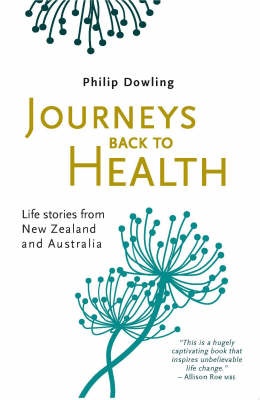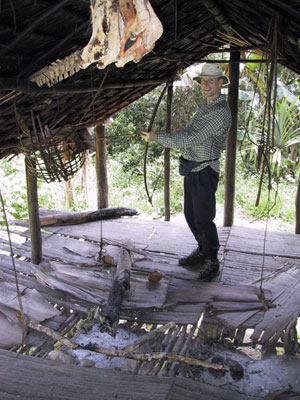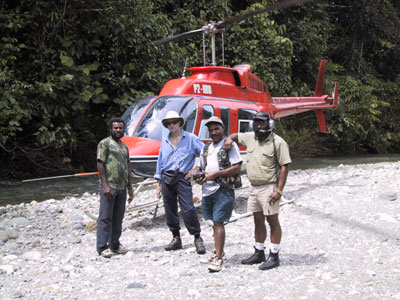 Glenn’s story – Five days that changed my life
Glenn’s story – Five days that changed my life
Asthma free after forty years
Excerpted from Journeys Back to Health – Philip Dowling
I suffered from eczema and breathing problems from birth and was diagnosed with asthma and chronic bronchitis at age two. At age four after two years of ongoing asthma and bronchitis the family doctor put me on a one year course of Penicillin.
I was prescribed numerous medications in childhood, including Intel and Berotec (Fenoterol). Berotec is a powerful short acting bronchodilator that was removed from sale in New Zealand after researchers here established a direct link with a sharp increase in asthma deaths1.
Asthma, sinus congestion and hay fever were a big part of my early years and medications were continuous. My earliest memories of hay fever were in 1970 when I emerged with red swollen eyes and nose streaming like a tap after playing in long grass. It was a shock at the time but I would get accustomed to experiencing these symptoms intermittently for the next thirty years. Leaving New Zealand for the USA in 1972, I noticed a mild improvement in my asthma but the only respite from hay fever was the winter months when there was three feet of snow on the ground.
I remember one very severe asthma attack after winning a 400 yard school race. As I crossed the finish line I could feel my chest tighten but rather than face my friends, I continued to run off the track and out to the main road where I flagged down a car to drive me to the doctor’s surgery. By the time I had reached the surgery, two miles up the road, the attack was so severe that it would not respond to bronchodilators, and I was given a shot of adrenaline.
I returned to New Zealand in 1976 to enrol at Auckland University for a Bachelor of Science. Not long after returning, my asthma steadily deteriorated and in 1977 my doctor referred me to one of Auckland’s leading respiratory specialists. After reviewing my asthma history and triggers (exercise, animal fur, beer, grass pollens), he recommended I should avoid animals and places where I might be exposed to pollens, to stay indoors in the middle of the day, and to avoid beer. He also advised that I would need asthma medication for the rest of his life. Great news at age eighteen. I ignored all the advice except to take medication.
Asthma attacks were a daily occurrence at this time. I still have vivid memories of an attack that happened when I was nineteen. I was sitting in a lecture theatre one day, and felt my chest start to tighten. With no medication on me, I ran from the theatre, and found my car outside. I drove home at speed running several red lights, getting bluer and bluer, rushed inside the house, ran up the stairs, and fumbling for the Berotec inhaler started pumping it. Unfortunately, there was no breath left to inhale the spray and I was losing consciousness. However I managed to keep pumping and at last felt my airways start to open up. That first breath was bliss but there was a clear lesson learned: from now on I would never go anywhere without my blue inhaler.
 Looking back to that episode, it was a mistake to drive home. I should have gone straight to the hospital or the university medical clinic. It reveals the levels I would go to conceal the severity of my asthma, even to the point of deluding myself that these attacks were not life threatening. I considered my asthma as a sign of weakness, and would only puff in private, always concealing my medication.
Looking back to that episode, it was a mistake to drive home. I should have gone straight to the hospital or the university medical clinic. It reveals the levels I would go to conceal the severity of my asthma, even to the point of deluding myself that these attacks were not life threatening. I considered my asthma as a sign of weakness, and would only puff in private, always concealing my medication.
I graduated in 1983 and after three years working in New Zealand, took a job with a mineral exploration company in Vanuatu. The first six weeks in the tropical jungles were surprisingly asthma free but by the second tour of duty my asthma returned and I was back on my daily medication. One such attack happened at the onset of the rainy season. I was running a drilling project on the island of Espiritu Santo in the north of Vanuatu. This time my blue puffer was of no use and I was rushed by helicopter to the local hospital and put on a nebuliser. Another close call. A course of antibiotics and oral steroids were required to stabilise me.
This was the first of many such potentially fatal asthma attacks that were to recur over the next fifteen years, many in remote locations. Episodes of chronic bronchitis resulting and deteriorating asthma became more frequent, and my doctor in New Zealand would write out prescriptions for multiple courses of antibiotics at a time to take with me. I would also pack dozens of preventer and reliever medications to last six to nine months as these were expensive and hard to come by in the remote locations I was posted.
In 1987 I moved to Indonesia to direct gold exploration projects. These were for the most part in remote equatorial jungles and work stints were for six to nine weeks at a time. My asthma began to deteriorate from the moment I went into the jungle. I knew to start increasing the inhaled steroid preventer to the maximum dose four to five days before entering the jungle. Despite this I was still using the blue puffer constantly. By the end of a typical stint my asthma was chronic and I also had bronchitis requiring antibiotics.
 I also suffered ongoing chronic sinusitis requiring daily antihistamines, sinus headaches requiring aspirin, eczema requiring daily hydrocortisone cream and daily bouts of allergic conjunctivitis for which I used some heavy duty eye drops and antibiotic ointment for severe cases.
I also suffered ongoing chronic sinusitis requiring daily antihistamines, sinus headaches requiring aspirin, eczema requiring daily hydrocortisone cream and daily bouts of allergic conjunctivitis for which I used some heavy duty eye drops and antibiotic ointment for severe cases.
And if this weren’t enough, I would frequently be woken in the middle of the night with a gasping, choking sensation and racing heart. These episodes were often so severe that I was convinced I was having a heart attack. They were very disorienting, and due to the extensive travel, I would often be awoken and for several minutes have no idea where I was. It was only years later that I came to realise that these episodes were panic attacks, most likely brought on by the stress of my job and overuse of the blue asthma puffer.
By 1999, the attacks were getting more severe and in one instance I had to be evacuated by helicopter with severe asthma and admitted to an emergency medical facility in Jakarta. My daily medication regime by now was two puffs of Pulmicort 400 mcg morning and night. Pulmicort is an inhaled corticosteroid preventer medication designed to reduce the inflammation in asthma. However, despite taking high doses of preventer supplemented with oral steroids, my asthma was poorly controlled.
In late 1999 I had based myself in London and the asthma had deteriorated to the point that I was unable to go back to my job in South East Asia. Even a whiff of second-hand smoke could trigger a violent attack by now. At this time I had three near-fatal attacks.
On one occasion my airways closed up and I couldn’t breathe. My puffer was useless and now in a panic I jumped in a black cab asking to be rushed to the nearest hospital. By the time I reached the emergency unit of the University College Hospital in Euston I was almost blue and the staff rushed me past a full waiting room to put me on a nebulizer. I remember seeing a sign warning of a four-hour waiting time for non-urgent medical attention. I guess near death is urgent and this life-saving action by the good doctors was a wake-up call.
During this time in London, I saw a number of doctors, and the advice to take a short course of prednisone to stabilise the asthma, and then ongoing preventer and reliever medication as needed was always the same. Despite several courses of prednisone and high doses of steroid inhaler medication, my condition was worsening fast.
It seemed to me that western medicine had run its course and that my asthma had reached the point where it was only a matter of time before it would kill me. By this time the symptoms were chronic and continuous; night time was the worst. Asthma was my life, at least what was left of it! The medications I had come to depend on were never out my sight and many of the foods I used to enjoy had to be avoided in case they might trigger a fatal attack.
Around this time I tried many alternative therapies including acupuncture, homeopathy, Chinese herbal medicine, and colonic irrigation. None of these had alleviated the symptoms. However, the most recent, near-fatal attack prompted me to follow up on advice I had received from the mother of a boy who had completely beaten his asthma after doing a breathing retraining course in Bali. The course was called Buteyko.
The technique could apparently greatly assist asthma sufferers. I tracked down a Buteyko practitioner by the name of Russell Stark in Newcastle. During our brief phone conversation, Russell told me that my asthma was a symptom of incorrect breathing. By learning to breathe correctly I would be able to overcome my asthma symptoms. He also said the results were guaranteed. On this basis, I felt there nothing to lose. But being a sceptical scientist and having tried so many other techniques without success, I had little expectation that Buteyko would work for me.
But work it did and the results were amazing! The wheezing and chest tightness that had been with me continuously for three months started to clear from the first session. Within three days I was breathing normally and no longer needing the Ventolin medication I had taken daily for most of my life. This was all the more remarkable for the fact that I had become so dependant that I was taking 20 puffs of Ventolin a day prior to doing the course. After five 90-minute sessions I was breathing easier than I could ever remember.
Six weeks after completing the course I had experienced no symptoms whatsoever, and hadn’t needed to use my Ventolin at all. After consulting a doctor in London, I was first advised to reduce and then after further consultation decided to stop taking the preventer medication altogether. For the first time in forty years I was now completely free of asthma symptoms and the need for daily medication.
I now indulge my love of all foods without the fear of asthma. Activities like running, hiking and swimming can now be enjoyed without getting breathless or needing to take asthma medication. My sinusitis and hay fever have cleared up and I no longer take a daily antihistamine tablet. And those debilitating panic attacks that used to wake me out of a deep sleep are a thing of the past; I sleep through the night to awake refreshed with energy to burn.
This may seem like some miracle cure but the science behind the ‘miraculous’ turnaround in my health is easily explained. My symptoms of asthma, hay fever and panic attacks were manifestations of incorrect breathing and quickly resolved as my breathing improved.
Now in my fifties I can exercise without getting asthma or breathlessness, and have completed the Round the Bays run countless times, completing the 8km course in just over fifty minutes and breathing through my nose throughout. I ran in the Round the Bays thirty years ago, in my twenties, and would have to stop repeatedly to puff on a Ventolin. Leg cramps would also stop me in my tracks - these too I now realise were a consequence of my poor breathing.
So what had I discovered over those five days that could so powerfully change my life? Simply I learned how to shift from mouth breathing to nasal-dominant breathing. I learned that by changing the emphasis from upper chest to diaphragmatic breathing, I could breathe in a relaxed, controlled way that would completely relieve my symptoms. I also learned a simple breathing technique to help clear even the most stubborn blocked nose. The exercise involves a short breath hold allowing carbon dioxide levels in the nasal passages to increase. Carbon dioxide helps relax the muscles lining the airways allowing them to open up clearing the nasal passages.
This life-changing experience so impressed me that in 2001 I turned my back on an eighteen-year career in mineral exploration to train as a Buteyko Institute practitioner in the UK and returned to Auckland to open the Buteyko Breathing Clinic.
The clinic opened its doors in 2002. As of December 2013 over 6,000 adults and children have learned the programme for conditions including snoring, sleep apnoea, asthma, allergies, hay fever, chronic bronchitis, dental disorders, stress-related conditions, panic attacks and chronic fatigue.
I am passionate about this simple, yet revolutionary approach to health and wellbeing and am committed to helping incorporate Buteyko into general practice to reduce the burden of breathing disorders like sleep apnoea, allergies and asthma in New Zealand and worldwide.
Glenn White BSc MSc MBIBH
Buteyko Practitioner/Practitioner Trainer BIM/ Director
Buteyko Breathing Clinics Ltd

1 Neil Pearce, Adverse Reactions: The Fenoterol Story Auckland University Press

 Glenn’s story – Five days that changed my life
Glenn’s story – Five days that changed my life Looking back to that episode, it was a mistake to drive home. I should have gone straight to the hospital or the university medical clinic. It reveals the levels I would go to conceal the severity of my asthma, even to the point of deluding myself that these attacks were not life threatening. I considered my asthma as a sign of weakness, and would only puff in private, always concealing my medication.
Looking back to that episode, it was a mistake to drive home. I should have gone straight to the hospital or the university medical clinic. It reveals the levels I would go to conceal the severity of my asthma, even to the point of deluding myself that these attacks were not life threatening. I considered my asthma as a sign of weakness, and would only puff in private, always concealing my medication. I also suffered ongoing chronic sinusitis requiring daily antihistamines, sinus headaches requiring aspirin, eczema requiring daily hydrocortisone cream and daily bouts of allergic conjunctivitis for which I used some heavy duty eye drops and antibiotic ointment for severe cases.
I also suffered ongoing chronic sinusitis requiring daily antihistamines, sinus headaches requiring aspirin, eczema requiring daily hydrocortisone cream and daily bouts of allergic conjunctivitis for which I used some heavy duty eye drops and antibiotic ointment for severe cases.
